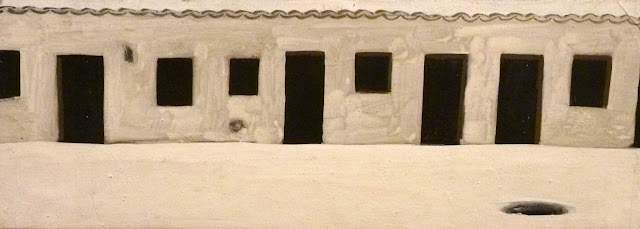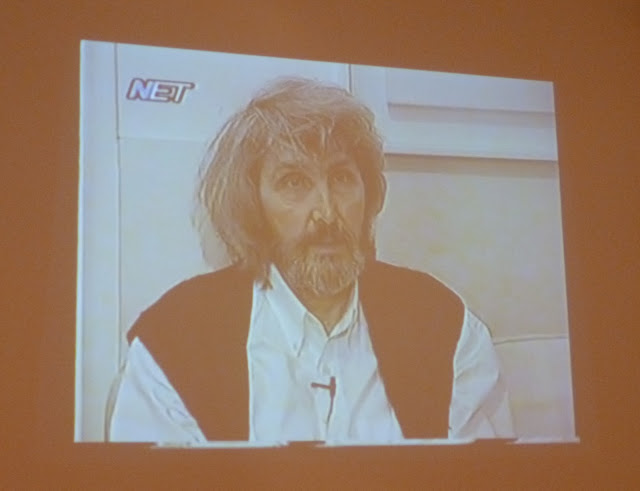Sotiris Sorogas, 50 years, at the Benaki Museum, Pireos Street Annexe.
We saw this exhibition three weeks ago but I have only now managed to finish the post. As all retrospectives, it is very interesting in that it shows the development of the artist.
The very early works are similar to those of Moralis, Papavasiliou and others of the 'golden period' of Greek painting who studied at the same school of art. The paintings of the 60s are different because they have colour, something that is absent in his later work. It is also interesting to note that the themes that fascinate him are present from early on, namely, crumbling walls, ruined houses, decay.
The early years
Landscape in Vouliagmeni, 1958
Houses, 1959
The 1960s
Ruins, 1966
Garden Wall, 1968
Workers' Houses at the Plaka Settlement in Laurio, 1969
Wall, 1968
Part of Ruined Wall, 1967
Part of Ruined Wall, 1967
Garden Gate, 1966
Sea Water-soaked Timbers, 1966
Ruins in the Snow, 1966
Landscape, Kaisariani, 1965
Landscape, Kaisariani, 1965
Red Poppy and Stones, 1972
Crumbling Wall, 1970
Portraits
Alexandra, 1984
Portrait, 1982
Rachel Kapon, 1999
Black Openings
Black Opening, 1982 (acrylic and charcoal on canvas)
Black Opening, 1982
Well in Amorgos, 1983, (acrylic and charcoal on canvans), four different studies
Well in Amorgos, 1983
The 'Wood' Series
The 'Wood' series on the right
Ruin in Pilio, 1984
Ruin, 1980
Ruins in Xanthi
Burnt House, 1980
Stones
This is one of the prevailing motifs in Sorogas' work and one that is reminiscent of the Greek landscape. The increased use of white is occasionally broken by a small splash of colour, sometimes a red poppy which could be connected to Seferis' 'Flowers of the Rock Facing the Green Sea', a major influence on Sorogas, or a piece of fabric, reminders of human presence.
Stones and Red Cloth, 1990
Chunks of Marble, 1999 (acrylic on canvas)
Rust
Time and decay continue as the main themes in this series. The remains of pieces of machinery, cranes and cogs from the quarries of Laurio and Pendeli are the subjects of this series of paintings - white has been sibstituted by the earthy tones of brown and ochre depicting with exhausting persistence disintegration and decay.
Chains on Pebbles, 1997 (acrylic and charcoal on canvas)
Metal Sheets, Diptych Part I, (acrylic on canvas) 1995
Metal Sheets, Diptych II, (acrylic on canvas) 1995
Equipment from an old Quarry I, 1995, (acrylic and charcoal on canvas)
Rust, 1993, (acrylic and charcoal on canvas)
Discarded Equipment, 1998, (acrylic and charcoal on canvas)
Part of Old Machinery, 1998, (acrylic and charcoal on canvas)
Mooring on the Beach in the Mani Region, 1996, (acrylic and charcoal on canvas)
Metal Near the Sea, 2007, (acrylic and charcoal on canvas)
Barrel
Sea Water-Soaked Timber
Parts of old barges, thick chains for mooring ships, forgotten and wrecked boats, ruined caiques - a series of works that Sorogas is still working on. Talking about this series of work, he refers to the following lines by Seferis:
What are they after,
Our Souls,
Travelling on rotten, sea water-soaked timbers
From harbour to harbour?
Sorogas says: "I am trying to deal with this subject - not the boat or caique in its entirety, but a part of it, a fragment of it, which is already wrecked, often making it hard to tell where this piece of timber came from and which suggests the distant presence of a vessel that used to travel in the open sea and now lies deserted on a shore".
Sea water-soaked Timbers, Tetraptych, 2010, (acrylic on canvas)
I
II
III
IV
Old Boat in Syros, 2006 (acrylic on canvas)
Wooden Platform (acrylic)
Sea water-soaked Timbers, 2010

























































How on earth did you manage to get INSIDE the black opening looking out? You must have magical powers...
ReplyDeleteHa! Ha! Ha! Sally, very good. I do have magic powers indeed.
DeleteSeriously though, it is so difficult photographing paintings or photographs that have glass as the reflection always gets in the way of the photograph.
Thank you for these photos. I just discovered Sorogas in the airplane magazine while flying from Rhodes to Lisbon yesterday. It seems to me there is an unique approach to scatology in some Greek contemporary painting...António
ReplyDeleteHa! Ha! Ha! It depends how you look at it, Antonio.
ReplyDelete